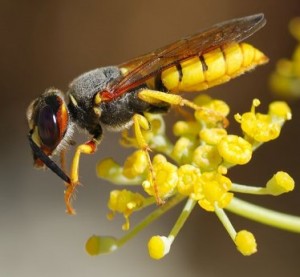
From http://en.wikipedia.org/wiki/File:Wasp_August_2007-12.jpg
Scientists from both the Max Planck Institute for Chemical Ecology and the University of Regensburg studied the reproductive process of this species, and they found an amazing thing: the female uses a cocktail of antibiotics to protect her young.1 Where does the female get those antibiotics? From bacteria that she cultures in her antennae!
The bacteria are from the genus Streptomyces, and they produce a mixture of nine different antibiotics. Each one is only moderately effective as an antibiotic, but when all of them exist together, they provide powerful protection against pathogenic bacteria and fungi that live in the soil in which the beewolves dig their tunnels.
Not only does the female beewolf culture these bacteria in her antennae, she actually paints them on the walls and ceilings of the tunnels in which she lays her eggs. That way, the larvae hatch with an “antibiotic shield” around them. The protection doesn’t stop there, however. The larvae take up some of these bacteria, and they then transfer them to their cocoons so that they are also protected during metamorphosis!
This is an amazing means by which the beewolf protects her young, and it mirrors what happens in human pharmacology today. As one of the scientists involved in the study says, this cocktail of antibiotics protects the larvae
in a manner similar to combination therapy used in human medicine.2
The design we see in nature is truly astounding, and it is clear evidence for the fact that the world and everything it has been made by an incredible DESIGNER.
REFERENCES
1. Beewolves Protect Their Offspring With Antibiotics; Digger Wasp Larvae Use Bacteria Against Infections, Science Daily, 2010, Available online
Return to Text
2. As quoted by Sara Everts, “Wasps’ Nursery Defense,” Chemical and Engineering News, March 15, 2010, p. 54
Return to Text
